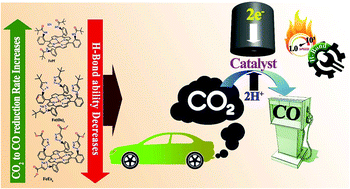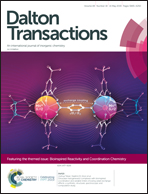Role of 2nd sphere H-bonding residues in tuning the kinetics of CO2 reduction to CO by iron porphyrin complexes†
Abstract
Iron porphyrins are potential catalysts for the electrocatalytic and photocatalytic reduction of CO2. It has been recently established that the reduction of CO2 by an iron porphyrin complex with a hydrogen bonding distal pocket involves at least two intermediates: a Fe(II)–CO22− and a Fe(II)–COOH species. A distal hydrogen bonding interaction was found to be key in determining the stability of these intermediates and affecting both the selectivity and rate of CO2 reduction. In this report, a series of iron porphyrins that vary only in the distal H-bonding network are further investigated and these exhibit turnover frequencies (TOFs) ranging from 1.0 s−1 to 103 s−1. The experimental TOFs correlate with the H-bonding ability of the distal superstructure of these iron porphyrin complexes and analysis suggests that H-bonding alone can tune the rate of CO2 reduction by as much as 1000 fold. DFT calculations provide a detailed insight into how the, apparently weak, 2nd sphere interactions lead to efficient CO2 activation for reduction. The ability to tune CO2 reduction rates by changing the H-bonding residue instead of the acid source is a convenient way to tune CO2 reduction electrocatalysis without compromising selectivity by introducing competitive hydrogen evolution reaction or formate generation.

- This article is part of the themed collection: Bioinspired reactivity and coordination chemistry


 Please wait while we load your content...
Please wait while we load your content...